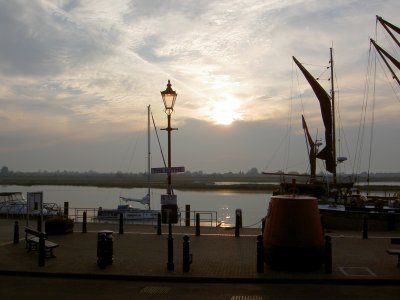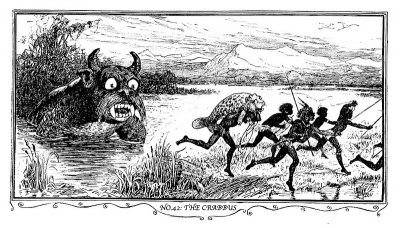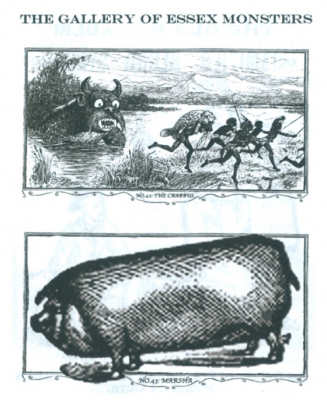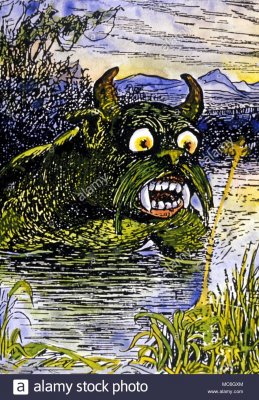Burgric
Fresh Blood
- Joined
- May 22, 2019
- Messages
- 8
- Location
- UK
My hometown, Maldon, is regarded as the 'most haunted town in Essex', UK. Much of the architecture is at least 300-400 years old, with one pub, the Blue Boar Inn dating back to the 1350s. It is no surprise that there are numerous supernatural happenings and stories around the district, given the ancient history of the place.
On a ghost walk some five or so years ago I learned about one such folk tale, that of Crabbus. I was a university student at the time, visiting home for a short break and staying with family.
The ghost walk tour guide took our group all over town, recounting several morbid tales before ending the tour at the Hythe near promenade park, Maldon's largest attraction, where he recounted the brutal and tragic tale of Crabbus. Below is an image of the Hythe near the prom.

Maldon's promenade park is situated on the river Blackwater, in Saxon times known as the Panta. The estuary snakes eastward towards the North sea, flowing past Northey and Osea islands on its way as seen below.

As you can imagine we have a lot of mud, the perfect environment for a half-man, half-crab horror. The tour guide regaled that Crabbus was born to a unnamed townswoman of Maldon in the 1800s, and upon being delivered was deemed too offensive to nature to be allowed to live. The baby was taken to the river by the mayor to be drowned.
Another speculation is that the baby was the illegitimate offspring of the town's mayor, a surplus motivation to rid of the child beside its offensive appearance. When the mayor, standing in the shallows of the river, lowered the baby into the water to drown it, the child slipped away and out of his hands before any such wrong could be committed.
The creature is said to have slipped down into the mud caverns beneath the riverbed, living a subterranean existence, only emerging for food, or an altogether more sinister purpose.
Rev. Joseph Arkwright wrote in his diary in 1863, 'As any fool know, to walk after dark through promenade park, is to walk in the shadow of death, for there the Crabbus Man lurks and scuttles, with his clacking claws and twitching eye-stalks, ready to leap upon the unwary and clack at them- they whose souls shall know no peace, for all their remaining days upon the earth'.
Quite a sinister portents, you might say.
I was so enthralled by this story that upon returning to university where I was studying music at the time, I wrote a song about Crabbus Man and performed it with the prog-rock band I was in at the time. Below is an embarrassingly low-resolution image of us performing it live.

When looking for information on the legend online, I only came across one major source, that of Essex Terror, a website dedicated to supernatural occurrences about Essex. On the website, nearly word-for-word, was the story of Crabbus the tour guide has recounted a few days before, complete with the quote from Rev. Arkwright. This led me to believe that the tour guide had used Essex Terror as a source during the process of writing his tour.
After graduating I moved back to my hometown, and feeling connected once more to my surroundings decided I would write a short story about Crabbus. To refresh my memory, I went online and searched for Essex Terror on Google, but got no hits.
I did, however, make contact with the owner of the website via Twitter and he generously sent me all the information he had on the Crabbus legend, including some artists renderings of Crabbus, one produced below.

In talking to the website author I mentioned I was writing a short story on the legend. He sent me a story he had written, and I read it. The piece had me in stitches. The author's style was largely satire and farce, the story poking fun at many local idiosyncrasies and places.
Two years later while preparing this story for a new YouTube channel I was starting on British Folklore, I read through all my old email correspondence with the author of Essex Terror. I viewed them in a new light. Several clues hinted that not all was as it seemed with the Crabbus legend.
After conducting hours of further investigation and research online, I came to the conclusion that the Crabbus legend was in fact a modern, urban legend, created and perpetuated by a handful of people.
If this was true, this is the story of how three people fooled me, any web visitor to Essex Terror, the ghost walk tour guide and the subsequent hundreds of people attending his tours.

Another image of the promenade park at its entrance near the Hythe.
When I began to scrutinise the information sent to me by the author of Essex Terror in Jan 2016, my suspicion was raised. The quote from Rev. Arkwright was sent to Essex Terror by an anonymous contributor in an article titled, 'Maldon: The Most Haunted Town in Essex', published in 2010.
The story of Crabbus' origins comes from a locally-published, home-printed pamphlet handed to the author at the Maldon Regatta (a yearly nautical festival we have) in 2011.
Both of these sources the author of Essex Terror informed me he had lost contact with, and could therefore not verify the contributors' information. The image of Crabbus above, reproduced below as a thumbnail, shows a picture card, one of 42 supposedly printed in 1912 of Essex Monsters. The creature is a hairy, walrus-like beast, glowering at what do not appear to be modern humans, by virtue of their dress and weapons. The legend of Crabbus was born in the 1800s, throwing out any credibility that this drawing represents Crabbus, not to mention the out-of-place mountains in the background of the image.

I then found this image while searching online for 'Maldon Crabbus', the link leading me to the page of the author of Essex Terror's Medium website.

The page showed a collection of amusing fake news articles from the early 20th century.
I returned to an earlier source of information, a man named Vom Vorton, who had also written a song about Crabbus. Vorton also happened to be the first person to alert the author of Essex Terror to the myth. I was told this during email correspondence with the author of Essex Terror.
I managed to track down Vom Vorton online and asked him a few questions. When I asked outright if Crabbus was a modern fabrication, he told me that it was 'mostly modern, although there are similar Essex legends that I've assumed were made up recently that actually date back further. Sometimes it's hard to tell.'
He went onto say, 'I was first told about the Crabbus Man in August 2006, when somebody asked me to write a song about him. Sadly I have lost touch with the person in question so I'm not sure whether they made him up.'
My memory was jogged. I seemed to remember that in the short story the author of Essex Terror had sent me years ago, the person who had first told Vom Vorton about Crabbus was mentioned. Sure enough, when I looked at the acknowledgements page, this nugget appeared:

It seems that the story begins with the mysterious figure known as Raz, who both the author of Essex Terror and Vom Vorton have lost touch with. Tempted to investigate further, and to find some contact information for Raz, I stopped myself.
I had become far too obsessed with the story, and by this point honestly did not want to know if Crabbus was indeed an utter fabrication. I suspected that it was, but something about the legend made me want to remain ignorant of its origins, however farcical and absurd.
In Maldon, crabbing is a sport most children and their parents engage in, and have done for hundreds of years. The goal is to hook crabs on a fishing line, drag them out of the estuary and plonk them in a bucket of water by your side, to gawk at.
Crabbus is known to wreak revenge on those that engage in the sport, as some kind of punitive justice for causing emotional trauma to crabs. Somehow, that makes Crabbus all the more human, and not just a hulking great half-man, half-crab abomination set on prowling the promenade park bent on bloodlust.
Another past-time in our town is the Maldon Mud Race, originally enforced in the winter months but recently moved to spring. The sport has hundreds of entrants each year, with the aim being to cross the estuary from one side of the mud bank to the other, through the water, and back again. Showers are set up on the quay for participants to wash off the black Maldon mud once they get out, and medals are awarded to all. It is funny to think of Crabbus sitting in his mud cavern below, rolling his eyes in irritation at all the noise going on above.
I did published a video that goes into more depth on the Crabbus legend at the Folklore Channel I previously mentioned, and it can be found here for those wanting a more visual experience of the legend or just some more information:
It is interesting to me that urban legends can be created and perpetuated so easily, and unsuspectingly in the guise of much older legends.
I would be interested to know your thoughts on this story, and if you have any local legends similarly horrific and bewildering.
On a ghost walk some five or so years ago I learned about one such folk tale, that of Crabbus. I was a university student at the time, visiting home for a short break and staying with family.
The ghost walk tour guide took our group all over town, recounting several morbid tales before ending the tour at the Hythe near promenade park, Maldon's largest attraction, where he recounted the brutal and tragic tale of Crabbus. Below is an image of the Hythe near the prom.

Maldon's promenade park is situated on the river Blackwater, in Saxon times known as the Panta. The estuary snakes eastward towards the North sea, flowing past Northey and Osea islands on its way as seen below.
As you can imagine we have a lot of mud, the perfect environment for a half-man, half-crab horror. The tour guide regaled that Crabbus was born to a unnamed townswoman of Maldon in the 1800s, and upon being delivered was deemed too offensive to nature to be allowed to live. The baby was taken to the river by the mayor to be drowned.
Another speculation is that the baby was the illegitimate offspring of the town's mayor, a surplus motivation to rid of the child beside its offensive appearance. When the mayor, standing in the shallows of the river, lowered the baby into the water to drown it, the child slipped away and out of his hands before any such wrong could be committed.
The creature is said to have slipped down into the mud caverns beneath the riverbed, living a subterranean existence, only emerging for food, or an altogether more sinister purpose.
Rev. Joseph Arkwright wrote in his diary in 1863, 'As any fool know, to walk after dark through promenade park, is to walk in the shadow of death, for there the Crabbus Man lurks and scuttles, with his clacking claws and twitching eye-stalks, ready to leap upon the unwary and clack at them- they whose souls shall know no peace, for all their remaining days upon the earth'.
Quite a sinister portents, you might say.
I was so enthralled by this story that upon returning to university where I was studying music at the time, I wrote a song about Crabbus Man and performed it with the prog-rock band I was in at the time. Below is an embarrassingly low-resolution image of us performing it live.
When looking for information on the legend online, I only came across one major source, that of Essex Terror, a website dedicated to supernatural occurrences about Essex. On the website, nearly word-for-word, was the story of Crabbus the tour guide has recounted a few days before, complete with the quote from Rev. Arkwright. This led me to believe that the tour guide had used Essex Terror as a source during the process of writing his tour.
After graduating I moved back to my hometown, and feeling connected once more to my surroundings decided I would write a short story about Crabbus. To refresh my memory, I went online and searched for Essex Terror on Google, but got no hits.
I did, however, make contact with the owner of the website via Twitter and he generously sent me all the information he had on the Crabbus legend, including some artists renderings of Crabbus, one produced below.
In talking to the website author I mentioned I was writing a short story on the legend. He sent me a story he had written, and I read it. The piece had me in stitches. The author's style was largely satire and farce, the story poking fun at many local idiosyncrasies and places.
Two years later while preparing this story for a new YouTube channel I was starting on British Folklore, I read through all my old email correspondence with the author of Essex Terror. I viewed them in a new light. Several clues hinted that not all was as it seemed with the Crabbus legend.
After conducting hours of further investigation and research online, I came to the conclusion that the Crabbus legend was in fact a modern, urban legend, created and perpetuated by a handful of people.
If this was true, this is the story of how three people fooled me, any web visitor to Essex Terror, the ghost walk tour guide and the subsequent hundreds of people attending his tours.
Another image of the promenade park at its entrance near the Hythe.
When I began to scrutinise the information sent to me by the author of Essex Terror in Jan 2016, my suspicion was raised. The quote from Rev. Arkwright was sent to Essex Terror by an anonymous contributor in an article titled, 'Maldon: The Most Haunted Town in Essex', published in 2010.
The story of Crabbus' origins comes from a locally-published, home-printed pamphlet handed to the author at the Maldon Regatta (a yearly nautical festival we have) in 2011.
Both of these sources the author of Essex Terror informed me he had lost contact with, and could therefore not verify the contributors' information. The image of Crabbus above, reproduced below as a thumbnail, shows a picture card, one of 42 supposedly printed in 1912 of Essex Monsters. The creature is a hairy, walrus-like beast, glowering at what do not appear to be modern humans, by virtue of their dress and weapons. The legend of Crabbus was born in the 1800s, throwing out any credibility that this drawing represents Crabbus, not to mention the out-of-place mountains in the background of the image.

I then found this image while searching online for 'Maldon Crabbus', the link leading me to the page of the author of Essex Terror's Medium website.

The page showed a collection of amusing fake news articles from the early 20th century.
I returned to an earlier source of information, a man named Vom Vorton, who had also written a song about Crabbus. Vorton also happened to be the first person to alert the author of Essex Terror to the myth. I was told this during email correspondence with the author of Essex Terror.
I managed to track down Vom Vorton online and asked him a few questions. When I asked outright if Crabbus was a modern fabrication, he told me that it was 'mostly modern, although there are similar Essex legends that I've assumed were made up recently that actually date back further. Sometimes it's hard to tell.'
He went onto say, 'I was first told about the Crabbus Man in August 2006, when somebody asked me to write a song about him. Sadly I have lost touch with the person in question so I'm not sure whether they made him up.'
My memory was jogged. I seemed to remember that in the short story the author of Essex Terror had sent me years ago, the person who had first told Vom Vorton about Crabbus was mentioned. Sure enough, when I looked at the acknowledgements page, this nugget appeared:
It seems that the story begins with the mysterious figure known as Raz, who both the author of Essex Terror and Vom Vorton have lost touch with. Tempted to investigate further, and to find some contact information for Raz, I stopped myself.
I had become far too obsessed with the story, and by this point honestly did not want to know if Crabbus was indeed an utter fabrication. I suspected that it was, but something about the legend made me want to remain ignorant of its origins, however farcical and absurd.
In Maldon, crabbing is a sport most children and their parents engage in, and have done for hundreds of years. The goal is to hook crabs on a fishing line, drag them out of the estuary and plonk them in a bucket of water by your side, to gawk at.
Crabbus is known to wreak revenge on those that engage in the sport, as some kind of punitive justice for causing emotional trauma to crabs. Somehow, that makes Crabbus all the more human, and not just a hulking great half-man, half-crab abomination set on prowling the promenade park bent on bloodlust.
Another past-time in our town is the Maldon Mud Race, originally enforced in the winter months but recently moved to spring. The sport has hundreds of entrants each year, with the aim being to cross the estuary from one side of the mud bank to the other, through the water, and back again. Showers are set up on the quay for participants to wash off the black Maldon mud once they get out, and medals are awarded to all. It is funny to think of Crabbus sitting in his mud cavern below, rolling his eyes in irritation at all the noise going on above.
I did published a video that goes into more depth on the Crabbus legend at the Folklore Channel I previously mentioned, and it can be found here for those wanting a more visual experience of the legend or just some more information:
It is interesting to me that urban legends can be created and perpetuated so easily, and unsuspectingly in the guise of much older legends.
I would be interested to know your thoughts on this story, and if you have any local legends similarly horrific and bewildering.


